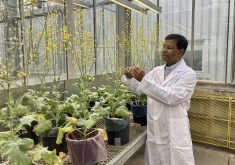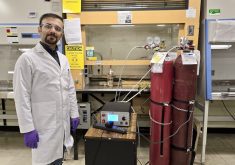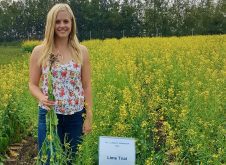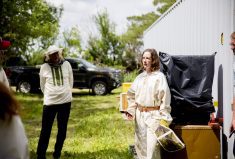Are honeybees raised in Alberta best suited to the province’s climate? That’s what researchers would love to find out.
“There are increasingly bee breeders who are operating locally and quite innovatively to provide queens where they are needed,” said Olav Rueppell, a University of Alberta professor who is an expert in honeybee biology.
“There might be a historical reason for why we are re-queening all the colonies before the spring but maybe there is a possible way to re-queen them before the winter.”
Read Also

Hail research hopes to benefit potato growers
Alberta research scientist measures hail storm and heat dome affects on potato crops
Alberta’s large beekeeping sector is highly dependent on imported honeybee queens, partly because there is little time to raise stock and distribute them during the short beekeeping season, he noted.
However, queens and other bee stock are often imported from southern regions, where they can be raised early and shipped very easily.
“That raises the question of whether those bees that have been bred and selected for success in other parts of the world, under very different conditions, are best for our local conditions here,” he said.

Rueppell was recently awarded $437,000 to study this question and other matters regarding bee health and vitality — a sign of how important the bee sector is for Prairie farmers.
Although honeybees pollinate a wide range of plants (such as fruit trees, veggies and pulses), they are key for canola production. And while native pollinators also play a critical role, studies have concluded honeybees can raise canola yields by double digits.
Rueppell’s study will look at three different stocks of bees (one local and two from stocks commonly imported here) in three different regions (near Edmonton, Grande Prairie and Lethbridge).
“That will tell us whether there are interactions, whether one type or one stock might be doing better in one area than another,” he said. “This particular project is not only about comparing the different stocks. It’s about how we can predict, at an individual level, the success of a queen.”
The three-year project will include identifying and examining genetic markers to see if they are better predictors than looking at phenotypic (that is, observable) traits, with the queens being the key focus.
“The queen is the heart and soul of the bee colony,” said Rueppell.
Researchers will also be studying colony level markers and assessing behavioural traits of the honeybees, such as how they clean their hive and react to substances that can cause brood diseases. Three collaborators (from AgCanada, the Alberta Beekeepers Commission and the University of Lethbridge) will monitor bee colony success, disease incidence, population buildup and other traits. They’ll be particularly interested in which stocks have the best overwintering success, and will also be doing a deep dive into the genetic makeup of the bees.
“Genetic analysis is quite involved. We’ll be looking at the whole genome of these stocks and compare them for genetic markers that have been previously identified.”

Although Alberta is Canada’s top honey producer, there hasn’t been a lot of genetic research done on bees here, but a major Genome Canada project has identified several good genetic markers, said Rueppell.
The research could also lead to a shift in bee selection. Along with production ability, bees are often selected for gentleness — and therefore less likely to sting their beekeeper.
But the study hopes to gain insight into whether, in the bee world, nice guys finish last.
The idea is that more aggressive bees might actually be ones that are “more sensitive to stimuli.”
“That alert mechanism may be a good defence mechanism against disease because they smell better or they notice something is wrong,” said Rueppell.
“We can optimize both traits if they are at the same gene or locus. But if they are independent and we can tweak one without the other, we can try to optimize multiple traits at the same time. That’s a more long-term goal.”
A more immediate one is to find “top colonies” that overwinter well and provide beekeepers with tests they can use to assess the quality and predict the survivability of their colonies.
“You can manage your quality accordingly,” he said. “If we know a colony is high quality, maybe you don’t need to treat pre-emptively against varroa mites or against other brood diseases — they are already genetically good enough to deal with that themselves.”
Having more robust bees is a lot better than “blanket treating everything all the time,” he added.
“Ultimately, I hope it will lead to a reduction in the cost of beekeeping because those chemical treatments are costly and labour intensive,” said Rueppell. “If we have stock that can take care of themselves, that would be the best solution.”
















